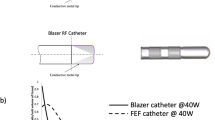Abstract
Effective ablation of atrial fibrillation and other cardiac arrhythmias requires precise catheter navigation and controlled delivery of energy to cardiac tissue. In this study, we summarize our initial experience using a fiber optic direct visualization catheter to evaluate and guide placement of endocardial radiofrequency (RF) ablation lesions. RF lesions were created in cadaveric porcine hearts and examined in a blood-filled field using a direct visualization catheter. Direct visualization of RF lesions was repeated in vivo using an ovine model. Lesions and interlesion gaps were clearly identifiable using the direct visualization catheter. It was possible to place lesions in proximity to anatomical landmarks and in relation to one another. Catheter-generated images correlated well with lesion appearance on gross examination. Direct catheter-based visualization is a feasible technique for guiding RF lesion placement, estimating lesion size, and identifying interlesion gaps. Future work is needed to correlate surface appearance with transmurality and electrical isolation.




Similar content being viewed by others
References
Scheinman, M. M. (2001). Catheter ablation: a personal perspective. Journal of Cardiovascular Electrophysiology, 12, 1083–1088.
Pappone, C., & Vincenzo, S. (2007). Remote navigation and ablation of atrial fibrillation. Journal of Cardiovascular Electrophysiology, 18, S1–S31.
Saliba, W., Reddy, V. Y., Wazni, O., Cummings, J. E., Burkhardt, J. D., Haissaguerre, M., et al. (2008). Atrial fibrillation using a robotic catheter remote control system: initial human experience and long-term follow-up results. Journal of the American College of Cardiology, 51, 2412–2413.
Chierchia, G. B., Capulzini, L., de Asmundis, C., Sarkozy, A., Roos, M., Paparella, G., et al. (2008). First experience with real-time three-dimensional transesophageal echocardiography-guided transseptal in patients undergoing atrial fibrillation ablation. Europace, 10, 1325–1328.
Barrett, C. D., & Natale, A. (2008). Toward balloon-based technologies: all that glitters is not gold. Journal of Cardiovascular Electrophysiology, 19, 952–954.
Schmidt, B., Antz, M., Ernst, S., Ouyang, F., Falk, P., Chun, J. K., et al. (2007). Pulmonary vein isolation by high-intensity focused ultrasound: first-in-man study with a steerable balloon catheter. Heart Rhythm, 4, 575–584.
Phillips, K. P., Schwikert, R. A., Saliba, W. I., Themistoclakis, S., Raviele, A., Bonso, A., et al. (2008). Anatomic location of pulmonary vein electrical disconnection with balloon-based catheter ablation. Journal of Cardiovascular Electrophysiology, 19, 14–18.
Neumann, T., Vogt, J., Schumacher, B., Dorszewski, A., Kuniss, M., Neuser, H., et al. (2008). Circumferential pulmonary vein isolation with the cryoballoon technique results from a prospective 3-center study. Journal of the American College of Cardiology, 52, 273–278.
Prystowsky, E. N. (2008). The history of atrial fibrillation: the last 100 years. Journal of Cardiovascular Electrophysiology, 19, 575–582.
Anh, D. J., Eversull, C. S., Chen, H. A., Mofrad, P., Mourlas, N. J., Mead, R. H., et al. (2008). Characterization of human coronary sinus valves by direct visualization during biventricular pacemaker implantation. Pacing and Clinical Electrophysiology, 31, 78–82.
Anh, D. J., Chen, H. A., Eversull, C. S., Mourlas, N. J., Mead, R. H., Liem, L. B., et al. (2006). Early human experience with use of a deflectable fiberoptic endocardial visualization catheter to facilitate coronary sinus cannulation. Heart Rhythm, 3, 875–878.
Fujimura, O., Lawton, M. A., & Koch, C. A. (1994). Direct in vivo visualization of right cardiac anatomy by fiberoptic endoscopy: observation of radiofrequency-induced acute lesions around the ostium of the coronary sinus. European Heart Journal, 15, 534–540.
Nazarian, S., Knight, B. P., & Dickfeld, T. L. (2005). Direct visualization of coronary sinus ostium and branches with a flexible steerable fiberoptic infrared endoscope. Heart Rhythm, 2, 844–848.
Themistoclakis, S., Wazni, O. M., & Saliba, W. (2006). Endoscopic fiberoptic assessment of balloon occlusion of the pulmonary vein ostium in humans: comparison with phased-array intracardiac echocardiography. Heart Rhythm, 3, 44–49.
Thiagalingam, A., D’Avila, A., Foley, L., Fox, M., Rothe, C., Miller, D., et al. (2008). Full-color direct visualization of the atrial septum to guide transseptal punture. Journal of Cardiovascular Electrophysiology, 19, 1310–1315.
Author information
Authors and Affiliations
Corresponding author
Rights and permissions
About this article
Cite this article
Eversull, C.S., Lin, B., Irani, A.R. et al. Direct Visualization of Cardiac Radiofrequency Ablation Lesions. J. of Cardiovasc. Trans. Res. 2, 198–201 (2009). https://doi.org/10.1007/s12265-009-9094-9
Received:
Accepted:
Published:
Issue Date:
DOI: https://doi.org/10.1007/s12265-009-9094-9




